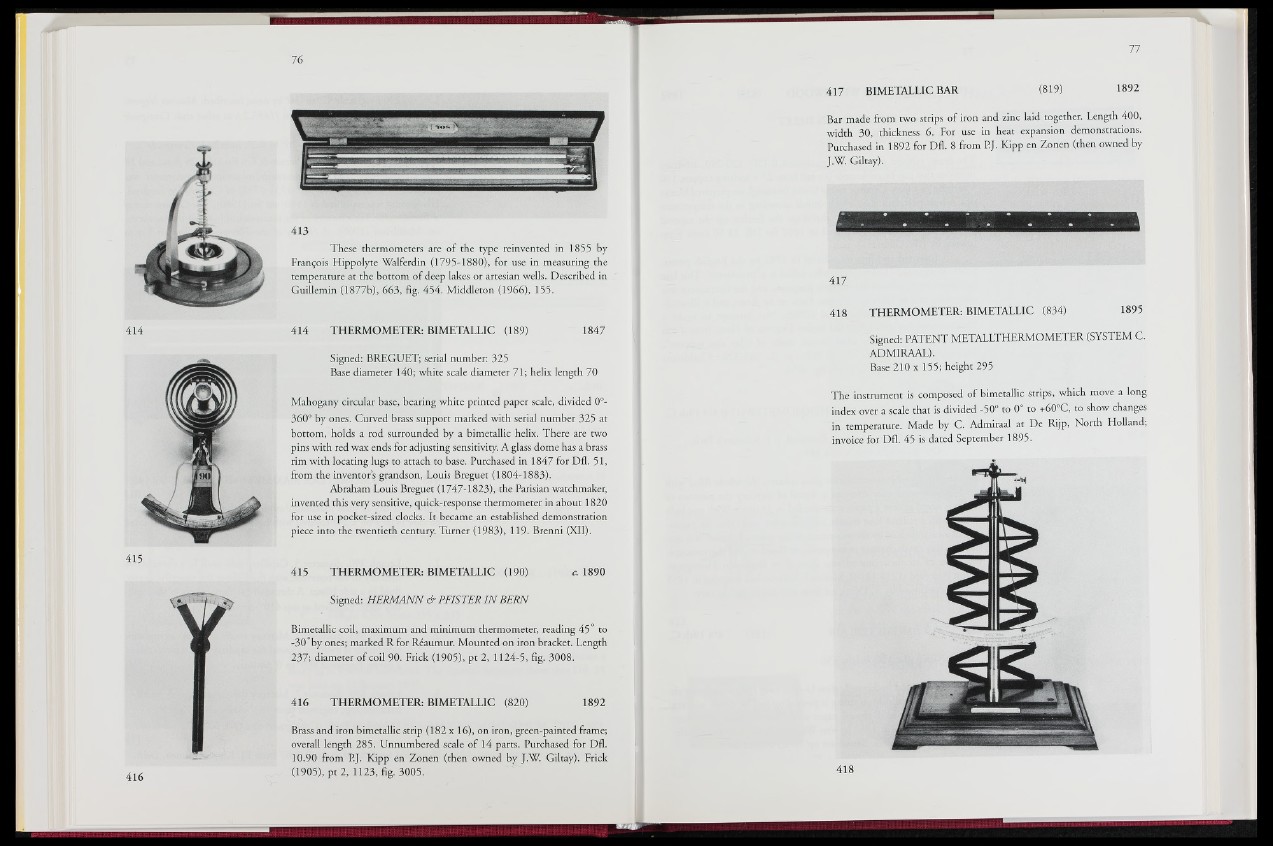
76
413
These thermometers are of the type reinvented in 1833 by
François Hippolyte Walferdin (1795-1880), for use in measuring the
temperature at the bottom of deep lakes or artesian wells. Described in
Guillemin (1877b), 663, fig. 454. Middleton (1966), 155.
414 THERMOMETER: BIMETALLIC (189) 1847
Signed: BREGUET; serial number: 325
Base diameter 140; white scale diameter 71; helix length 70
Mahogany circular base, bearing white printed paper scale, divided 0°-
360° by ones. Curved brass support marked with serial number 325 at
bottom, holds a rod surrounded by a bimetallic helix. There are two
pins with red wax ends for adjusting sensitivity. A glass dome has a brass
rim with locating lugs to attach to base. Purchased in 1847 for Dfl. 51,
from the inventors grandson, Louis Breguet (1804-1883).
Abraham Louis Breguet (1747-1823), the Parisian watchmaker,
invented this very sensitive, quick-response thermometer in about 1820
for use in pocket-sized clocks. It became an established demonstration
piece into the twentieth century. Turner (1983), 119. Brenni (XII).
415 THERMOMETER: BIMETALLIC (190) c. 1890
Signed: HERMANN & PFISTER IN BERN
Bimetallic coil, maximum and minimum thermometer, reading 45 to
-30° by ones; marked R for Réaumur. Mounted on iron bracket. Length
237; diameter of coil 90. Frick (1905), pt 2, 1124-5, fig. 3008.
416 THERMOMETER: BIMETALLIC (820) 1892
Brass and iron bimetallic strip (182 x 16), on iron, green-painted frame;
overall length 285. Unnumbered scale of 14 parts. Purchased for Dfl.
10.90 from P.J. Kipp en Zonen (then owned by J.W. Giltay). Frick
(1905), pt 2, 1123, fig. 3005.
417 BIMETALLIC BAR (819)- 1892
Bar maHp from two strips of iron and zinc laid together. Length 400,
width 30, thickness 6. For use in heat expansion demonstrations.
Purchased in 1892 for Dfl. 8 from P.J. Kipp en Zonen (then owned by
J.W. Giltay). I,
417
418 THERMOMETER: BIMETALLIC (834) 1895
Signed: PATENT METALLTHERMOMETER (SYSTEM C.
A DM IRA AL *
Base 210 x 155; height 295
The instrument is composed of bimetallic strips, which move a long
index over a scale that is divided -50° to 0 to +60°C, to show changes
in temperature. Made by C. Admiraal at De Rijp, North Holland,
invoice for Dfl. 45 is dated September 1895.